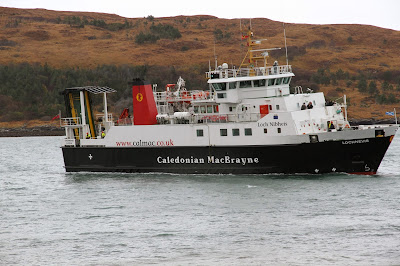The Mourning Dove was seen at first light, but it wasn't on view in the hour Ewan & I spent looking for it a little later that morning. We didn't hang around too long as Mike, the community ranger, had suggested a visit to Kilmory in the North of the island. This is a long valley heading off from the centre of the island with a number of small plantations at the Northern end. Overall, it was going to be a 10 mile walk. Once out of the village, the track climbs steadily into hills.
Rum: The track initially follows this river, but quickly leaves it
Rum: Looking back on the lower slopes above Kinloch village
Rum: This old winch has seen better days
Rum: A more typical of the upland moorland
On the walk a pair of White-tailed Sea-eagles headed down into Kinloch bay along the far ridge and presumably the same pair came back along the near hillside.
White-tailed Sea-eagle
Ewan disturbed a Snow Bunting on the track & it ended up feeding on the finest of grass seeds in a small quarry. However, it was surprisingly unapproachable for a Snow Bunting. A second bird was found on the walk back.
Snow Bunting
Snow Bunting
Rum: The upper part of the Kilmory valley, with Skye in the distance
Rum: The lower part of the Kilmory valley as another squall arrived. Fortunately, in the gusty winds, the rain clouds quickly passed through
The Red Deer in the Kilmory valley has been part of a long term study & the numbers are not managed in this part of Rum. As a result, the Red Deer were reasonable approachable.
Red Deer: A young buck
Red Deer: Two females
Red Deer: The general colouration was quite variable in the females
Unfortunately, I failed to get a picture of the best mammal seen on Rum: a Pygmy Shrew. The small size & lack of Common Shrews on Rum helped resolve the identification. As I've not been involved in any small mammal trapping, I've never managed to identify the Common/Pygmy Shrews I've seen before.
I had seen several Wrens & they appeared darker than the Dorset Wrens I'm used to. The regular UK subspecies, indigenus, reaches to the Inner Hebrides, with the darker hebridensis subspecies on the Outer Hebrides.
Wren: Presumably the darker hebridensis subspecies
I got back to Kinloch in time to have another look at the Mourning Dove which appeared about 30 minutes before dusk.
I started the following morning with a quick bit of birding around the village, prior to a look around Kinloch Castle, which I remember watching on the BBC Restoration series. This is an over the top hunting lodge and was only inhabited for a few weeks each year. Construction started in 1897 using imported red sandstone from Annan and took 3 years to build. It was the first private residence in Scotland to have
electricity using hydro electric power, which still supplies the village today. Sadly, there is a £15 million price tag to restore it to its former glory.
Kinloch Castle
Kinloch Castle: The entrance room
Kinloch Castle: The dining room
Kinloch Castle: An early telephone for receiving calls, but not being able to talk back
Kinloch Castle: The ballroom, complete with balcony for 14 piece orchestra
Kinloch Castle: The castle had a collection of live Hummingbirds, until the heating failed, they died and ended up in this case
A Song Thrush proved that they are tame and approachable away from the Scillies.
Song Thrush
The Loch Nevis ferry arrived for the scenic return to Mallaig, via the smaller islands of Muck & Eigg.
The Loch Nevis ferry
After all the rain of the last couple of days, I wasn't surprised to see snow on the mountains.
Snow on the mountains behind Fort William
I travelled back South overnight, hoping that as the weather in Cornwall improved, that the Hermit Thrush would be relocated. Sadly, that wasn't the case. Still hoping for 3 ticks in a week was just being greedy.
























